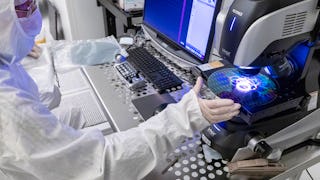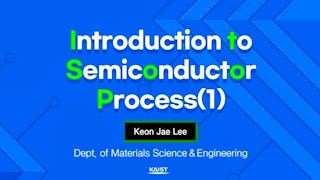This course will provide information on the various stages of semiconductor package manufacturing, including sort, assembly, and final test. In addition, we will also describe how to select, build, and test the packages with the die and other components to ensure the quality of the package and total assembly performance. We will also discuss the role of Process Control Systems in semiconductor manufacturing as they relate to quality testing. Specifically, we will explore how Process Control Systems can help identify and correct process problems that cause variation and quality issues. Finally, we also demonstrate how to use control charts to monitor the process performance. These can assist in decision-making, specifically when to take action to improve the process.

Enjoy unlimited growth with a year of Coursera Plus for $199 (regularly $399). Save now.

Semiconductor Packaging Manufacturing
This course is part of Semiconductor Packaging Specialization

Instructor: Terry Alford
3,982 already enrolled
Included with
(67 reviews)
Recommended experience
What you'll learn
Learn about the various stages of semiconductor package manufacturing.
The role of Process Control Systems in semiconductor manufacturing.
How Process control Systems can help identify and correct process problems.
How to use control charts to monitor process performance.
Skills you'll gain
Details to know

Add to your LinkedIn profile
7 assignments
See how employees at top companies are mastering in-demand skills

Build your subject-matter expertise
- Learn new concepts from industry experts
- Gain a foundational understanding of a subject or tool
- Develop job-relevant skills with hands-on projects
- Earn a shareable career certificate

There are 8 modules in this course
Welcome to Semiconductor Packaging Manufacturing, where we discuss the various stages of semiconductor package manufacturing, including sort, assembly, and final test. In addition, we will also describe how to select, build, and test the packages with the die and other components to ensure the quality of the package and total assembly performance. We will also discuss the role of Process Control Systems in semiconductor manufacturing as they relate to quality testing. Specifically, we will explore how Process Control Systems can help identify and correct process problems that cause variation and quality issues. Finally, we also demonstrate how to use control charts to monitor the process performance. These can assist in decision-making, specifically when to take action to improve the process.
What's included
1 video2 readings
In this module you will watch a lecture video by Principal Engineer, Dr. Mitul Modi from Intel as he discusses semiconductor package manufacturing. He will explain how semiconductor packaging is a complex process and discuss the three primary phases: sort, assembly, and final test.
What's included
1 video2 readings1 assignment
In this module, Dr. Mitul Modi discusses process flows for different types of semiconductor packages. He will explain how most process flows consist of three basic steps: sort, assembly, and final test. You will learn the details of how these steps vary depending on the package type. Mitul will give examples of process flows for BGA, LGA, 3D stacked LGA, and Stacked Hybrid packages. He will also mention that there are many more possible scenarios for process flows in semiconductor packaging.
What's included
1 video2 readings1 assignment
In this module, Dr. Mitul Modi discusses the assembly process of semiconductor packaging and their purposes. He explains how the die is prepared, attached to a substrate, and the importance of the epoxy process. He also discusses other assembly techniques for each of these steps.
What's included
1 video2 readings1 assignment
In this module, Dr. Mitul Modi discusses the different types of assembly steps in semiconductor packaging and their purposes. You will learn about the optional steps of IHS attach and ball attach, and how they improve the performance and reliability of the packages.
What's included
1 video2 readings1 assignment
In this module, Dr. Mitul Modi discusses the test and final stages of semiconductor packaging and their importance. He also describes how sort, burn-in, test and finish operations ensure the quality, functionality and reliability of the packages before they are delivered to the customer.
What's included
1 video2 readings1 assignment
In this module, Dr. Mitul Modi discusses the role and benefits of Process Control Systems (PCS) in semiconductor manufacturing. He will explain how PCS can detect and correct process problems that cause variation and quality issues. He will also define the concepts of targets, variation, common and special causes, control limits, and stability. Finally, he will demonstrate how to use control charts to monitor the process performance and to decide when to take action to improve the process.
What's included
1 video2 readings1 assignment
In conclusion of Introduction to Semiconductor Packaging, we would like to summarize the main takeaways. We started by sharing various aspects of nanoelectronics, transistor action, reliability, and customer ease of use. Then, we explored how Moore’s Law and market use conditions affect the packages' reliability needs and the materials/design choices. At the end, we saw how the common footprint of a motherboard or socket determines a package's substrate level interconnect. Thank you for joining us.
What's included
1 video1 assignment1 plugin
Earn a career certificate
Add this credential to your LinkedIn profile, resume, or CV. Share it on social media and in your performance review.
Instructor

Offered by
Explore more from Electrical Engineering
 Status: Free Trial
Status: Free TrialArizona State University
 Status: Free Trial
Status: Free TrialArizona State University
 Status: Free Trial
Status: Free TrialArizona State University
 Status: Preview
Status: PreviewKorea Advanced Institute of Science and Technology(KAIST)
Why people choose Coursera for their career




Learner reviews
67 reviews
- 5 stars
77.61%
- 4 stars
16.41%
- 3 stars
4.47%
- 2 stars
0%
- 1 star
1.49%
Showing 3 of 67
Reviewed on Dec 8, 2024
I appreciate This course and the insights you shared throughout the knowledge. This has been a rewarding learning experience, and I’m grateful for your guidance and support.

Open new doors with Coursera Plus
Unlimited access to 10,000+ world-class courses, hands-on projects, and job-ready certificate programs - all included in your subscription
Advance your career with an online degree
Earn a degree from world-class universities - 100% online
Join over 3,400 global companies that choose Coursera for Business
Upskill your employees to excel in the digital economy
Frequently asked questions
To access the course materials, assignments and to earn a Certificate, you will need to purchase the Certificate experience when you enroll in a course. You can try a Free Trial instead, or apply for Financial Aid. The course may offer 'Full Course, No Certificate' instead. This option lets you see all course materials, submit required assessments, and get a final grade. This also means that you will not be able to purchase a Certificate experience.
When you enroll in the course, you get access to all of the courses in the Specialization, and you earn a certificate when you complete the work. Your electronic Certificate will be added to your Accomplishments page - from there, you can print your Certificate or add it to your LinkedIn profile.
Yes. In select learning programs, you can apply for financial aid or a scholarship if you can’t afford the enrollment fee. If fin aid or scholarship is available for your learning program selection, you’ll find a link to apply on the description page.
More questions
Financial aid available,

